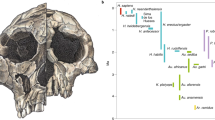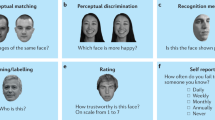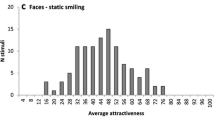Abstract
Over evolutionary time, humans have developed a selective sensitivity to features in the human face that convey information on sex, age, emotions, and intentions. This ability might not only be applied to our conspecifics nowadays, but also to other living objects (i.e., animals) and even to artificial structures, such as cars. To investigate this possibility, we asked people to report the characteristics, emotions, personality traits, and attitudes they attribute to car fronts, and we used geometric morphometrics (GM) and multivariate statistical methods to determine and visualize the corresponding shape information. Automotive features and proportions are found to covary with trait perception in a manner similar to that found with human faces. Emerging analogies are discussed. This study should have implications for both our understanding of our prehistoric psyche and its interrelation with the modern world.






Similar content being viewed by others
References
Albright, L., Kenny, D. A., & Malloy, T. E. (1988). Consensus in personality judgements at zero acquaintance. Journal of Personality and Social Psychology, 55(3), 387–395.
Argyle, M. (2002). Körpersprache & Kommunikation: Das Handbuch zur nonverbalen Kommunikation (8th ed.). Paderborn: Junfermann.
Ashmore, R. D., & Tumia, M. L. (1980). Sex stereotypes and implicit personality theory, I: A personality description approach to the assessment of sex stereotypes. Sex Roles, 6, 501–518.
Atzwanger, K. (1995). Der Steinzeitjäger im Straßenkreuzer: Humanethologische Aspekte aggressiven Auffahrens auf der Autobahn. Unpublished Doctoral thesis, University of Vienna.
Autodesk (2006). 3ds Max (Version 8). San Rafael, USA: Autodesk Media & Entertainment.
Bookstein, F. L. (1991). Morphometric tools for landmark data: Geometry and biology. New York: Cambridge University Press.
Borkenau, P., & Liebler, A. (1992). Trait inferences: Sources of validity at zero acquaintance. Journal of Personality and Social Psychology, 62, 645–657.
Brannigan, C. R., & Humphries, D. A. (1972). Human non-verbal behaviour, a means of communication. In N. G. Blurton Jones (Ed.), Ethological studies of child behaviour (pp. 37–64). London: Cambridge University Press.
Bulbulia, J. (2004). The cognitive and evolutionary psychology of religion. Biology and Philosophy, 19, 655–686.
Buss, D. M. (2004). Evolutionary psychology: The new science of the mind (2nd ed.). Boston: Pearson.
Cosmides, L., & Tooby, J. (1992). Cognitive adaptations for social exchange. In J. H. Barkow, L. Cosmides, & J. Tooby (Eds.), The adapted mind: Evolutionary psychology and the generation of culture (pp. 163–228). New York: Oxford University Press.
Coss, R. G. (2003). The role of evolved perceptual biases in art and design. In E. Voland, & K. Grammer (Eds.), Evolutionary aesthetics (pp. 69–130). Berlin: Springer.
Desmet, P. M. A., Hekkert, P., & Jacobs, J. J. (2000). When a car makes you smile: Development and application of an instrument to measure product emotions. In S. J. Hoch & R. J. Meyer (eds.) Advances in Consumer Research 27 (111–117).
Ekman, P. (1999). Basic emotions. In T. Dalgleish, & M. Power (Eds.), Handbook of cognition and emotion (pp. 45–60). Sussex, UK: John Wiley & Sons.
Enlow, D. H., & Hans, M. G. (1996). Essentials of facial growth. Philadelphia: Saunders.
Erk, S., Spitzer, M., Wunderlich, A. P., Galley, L., & Walter, H. (2002). Cultural objects modulate reward circuitry. NeuroReport, 13, 2499–2503.
Fink, B., Grammer, K., Mitteroecker, P., Gunz, P., Schaefer, K., Bookstein, F. L., et al. (2005). Second to fourth digit ratio and face shape. Proceedings of the Royal Society B, 272, 1995–2001.
Fiske, S. T., Cuddy, A. J. C., & Glick, P. (2007). Universal dimensions of social cognition: Warmth and competence. Trends in Cognitive Sciences, 11, 77–83.
Gauthier, I., Skudlarski, P., Core, J. C., & Anderson, A. W. (2000). Expertise for cars and birds recruits brain areas involved in face recognition. Nature Neuroscience, 3, 191–197.
Grammer, K., & Thornhill, R. (1994). Human (Homo sapiens) facial attractiveness and sexual selection: The role of symmetry and averageness. Journal of Comperative Psychology, 108, 233–242.
Guthrie, S. E. (1993). Faces in the clouds: A new theory of religion. New York: Oxford University Press.
Haselton, M. G., & Buss, D. M. (2000). Error management theory: A new perspective on biases in cross-sex mind reading. Journal of Personality and Social Psychology, 78, 81–91.
Henderson, J. M., Falk, R., Minut, S., Dyer, F. C., & Mahadevan, S. (2001). Gaze control for face learning and recognition in humans and machines. In T. Shipley, & P. Kellman (Eds.), From fragments to objects: Segmentation and grouping in vision (pp. 463–481). New York: Elsevier Science.
Hess, U., & Blairy, S. (2001). Facial mimicry and emotional contagion to dynamic emotional facial expressions and their influence on decoding accuracy. International Journal of Psychophysiology, 40, 129–141.
Juergens, M. (2003). Fies à vis. Auto Motor Sport, 25, 44.
Keating, C. F., Mazur, A., & Segal, M. H. (1977). Facial gestures which influence the perception of status. Sociometry, 40, 374–378.
Keating, C. F., Randall, D. W., Kendrick, T., & Gutshall, K. A. (2003). Do babyfaced adults receive more help? The (cross-cultural) case of the lost resume. Journal of Nonverbal Behavior, 27, 89–109.
Kenny, D. A., Horner, C., Kashy, D. A., & Chu, L. C. (1992). Consensus at zero acquaintance: Replication, behavioral cues, and stability. Journal of Personality and Social Psychology, 62, 88–97.
Kerssenbrock, F. (2005). Sie leben! Design. Emotion ist alles, wissen Autohersteller—und lassen ihre Modelle immer öfter nach dem Vorbild des menschlichen Gesichts gestalten. Profil, (March) 72–74.
Kohler, C. G., Turner, T., Stolar, N. M., Bilker, W. B., Brensinger, C. M., Gur, R. E., et al. (2004). Differences in facial expressions of four universal emotions. Psychiatry Research, 128, 235–244.
Lorenz, K. (1943). Die angeborenen Formen möglicher Entfaltung. Zeitschrift für Tierpsychologie, 5, 235–409.
Mark, L. S., Shaw, R. E., & Pittenger, J. B. (1988). Natural vonstraints, scales of analysis, and information for the perception of growing faces. In T. R. Alley (Ed.), Social and applied aspects of perceiving faces (pp. 11–49). Hillsdale: Lawrence Erlbaum Associates.
McCrae, R. R., & Costa, P. T. (1997). Personality trait structure as a human universal. American Psychologist, 52, 509–516.
Otta, E., Abrosio, F. F. E., & Hoshino, R. L. (1996). Reading a smiling face: Messages conveyed by various forms of smiling. Perceptual and Motor Skills, 84, 1111–1121.
Perrett, D. I., Lee, K. J., Penton-Voak, I., Rowland, D., Yoshikawa, S., Burt, D. M., et al. (1998). Effects of sexual dimorphism on facial attractiveness. Nature, 394, 884–887.
Pittenger, J. B., Shaw, R. E., & Mark, L. S. (1979). Perceptual information for the age level of faces as a higher order invariant of growth. Journal of Experimental Psychology: Human Perception and Performance, 5, 478–493.
Rohlf, F. J. (2005a). tpsDig2 (Version 2.04): Department of Ecology and Evolution, State University of New York at Stony Brook, New York.
Rohlf, F. J. (2005b). tpsPLS (Version 1.18): Department of Ecology and Evolution, State University of New York at Stony Brook, New York.
Rohlf, F. J. (2005c). tpsRegr (Version 1.31): Department of Ecology and Evolution, State University of New York at Stony Brook, New York.
Rohlf, F. J., & Corti, M. (2000). The use of two-block partial least-squares to study covariation in shape. Systematic Biology, 49, 740–753.
Rohlf, F. J., & Slice, D. E. (1990). Extensions of the Procrustes method for the optimal superimposition of landmarks. Systematic Zoology, 39, 40–59.
Schaefer, K., Fink, B., Mitteroecker, P., Neave, N., & Bookstein, F. L. (2005). Visualizing facial shape regression upon 2nd to 4th digit ratio and testosterone. Collegium Antropologicum, 29, 415–419.
Schirman, D. (2006). Der Citroen DS 19—“Die Göttin.” Design. France: ARTE.
Streissguth, A. P., Bookstein, F. L., Sampson, P. D., & Barr, H. M. (1993). The enduring effects of prenatal alcohol exposure on child development. Ann Arbor: University of Michigan Press.
Thayer, S., & Schiff, W. (1969). Stimulus factors in observer judgment of social interaction: Facial expression and motion pattern. American Journal of Psychology, 82, 73–85.
Ursi, W. J., Trotman, C. A., McNamara Jr., J. A., & Behrents, R. G. (1993). Sexual dimorphism in normal craniofacial growth. Angle Orthodontist, 63, 47–56.
Willis, J., & Todorov, A. (2006). First impressions: Making up your mind after a 100-ms exposure to a face. Psychological Science, 17, 592–598.
Acknowledgments
We want to thank Anika Bruns for her great support, and F. James Rohlf for his valuable comments and for the adjustment of his program tpsPLS for our purpose. We are also grateful to three anonymous reviewers for their thoughtful remarks. This work was funded by a research grant from EFS Unternehmensberatung, and, in part, by the Austrian Council for Science and Technology grant GZ 200.093/I-VI/I/2004 and the EU FP6 Marie Curie Actions grant MRTN-CT-2005-019564 (EVAN).
Author information
Authors and Affiliations
Corresponding authors
Rights and permissions
About this article
Cite this article
Windhager, S., Slice, D.E., Schaefer, K. et al. Face to Face. Hum Nat 19, 331–346 (2008). https://doi.org/10.1007/s12110-008-9047-z
Published:
Issue Date:
DOI: https://doi.org/10.1007/s12110-008-9047-z




